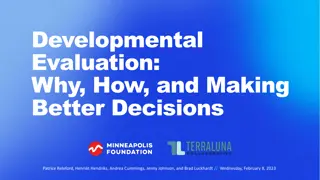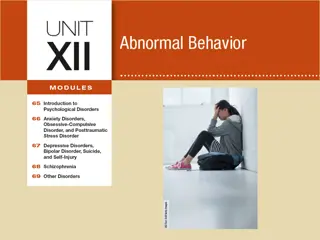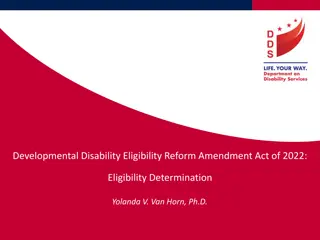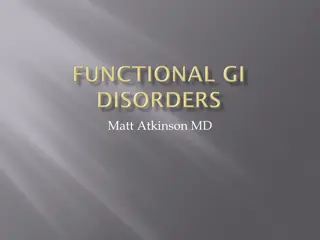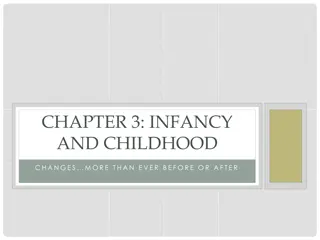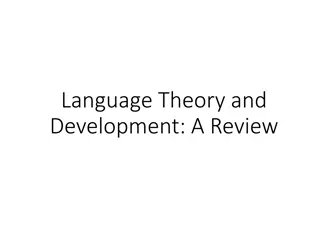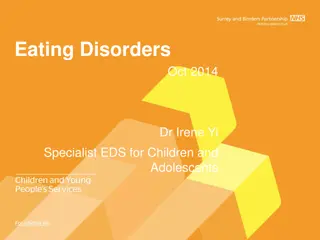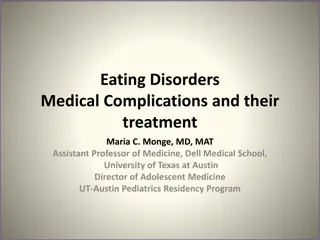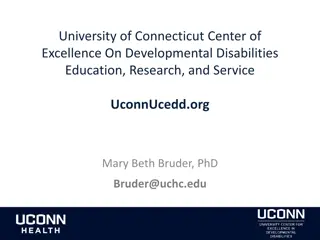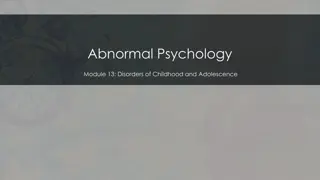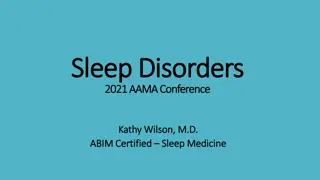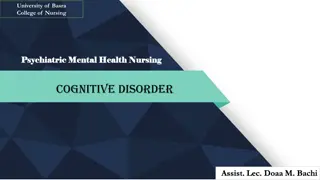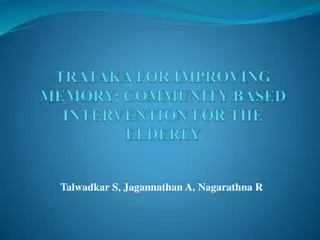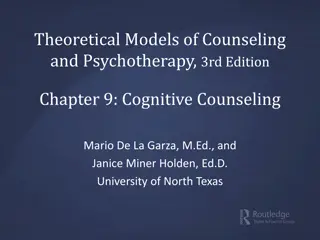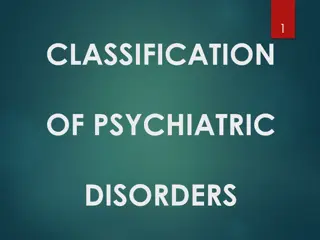Cognitive Developmental Disorders and Research Aims
Cognitive developmental disorders pose challenges in diagnosis due to high prevalence rates of ADHD, dyslexia, language impairment, and dyscalculia. The CALM clinic focuses on research-informed assessment of children with attention, learning, and memory problems to identify cognitive dimensions related to learning impairments and enhance diagnosis methods. By exploring meaningful dimensions of cognitive profiles cutting across various diagnoses, the clinic aims to improve individualized support for children with known cognitive profiles.
Download Presentation

Please find below an Image/Link to download the presentation.
The content on the website is provided AS IS for your information and personal use only. It may not be sold, licensed, or shared on other websites without obtaining consent from the author.If you encounter any issues during the download, it is possible that the publisher has removed the file from their server.
You are allowed to download the files provided on this website for personal or commercial use, subject to the condition that they are used lawfully. All files are the property of their respective owners.
The content on the website is provided AS IS for your information and personal use only. It may not be sold, licensed, or shared on other websites without obtaining consent from the author.
E N D
Presentation Transcript
? The CALM clinic: Data from the first 100 Children with problems in Attention, Learning and Memory Susan Gathercole, Francesca Woolgar, Duncan Astle, Tom Manly, & Joni Holmes Understanding and helping children with problems in attention, learning and memory, 16th June 2015
The Centre for Attention, Learning & Memory Aims to: understand cognitive and brain processes involved in learning develop ways of identifying and overcoming problems that might emerge in childhood provide an information hub for researchers and professionals in children s services
Cognitive developmental disorders: Problems of diagnosis High prevalence of ADHD, dyslexia, language impairment and dyscalculia (1-7% population) Co-morbidity rates 20-80% Diagnoses have low: specificity (high symptom variability) & sensitivity (high symptom overlap with other diagnoses)
Cognitive developmental disorders: Problems of diagnosis High prevalence of ADHD, dyslexia, language impairment and dyscalculia (1-7% population) Co-morbidity rates 20-80% Diagnoses have low: specificity(high symptom variability) & sensitivity (high symptom overlap with other diagnoses) Dimensional approach: identify meaningful dimensions of cognitive/ behavioural profiles that cut across diagnoses
The CALM clinic Research-informed assessment of children with problems in attention, learning, and/ or memory, with the aims of: identifying cognitive dimensions linked to impairments of learning (reading, maths, language) illuminating the neural and genetic characteristics of these dimensions improving diagnosis and tailoring support for individuals establishing a research panel of children with known cognitive profiles for fundamental and translational research
Possible dimensions Phonological Nonverbal Executive functions Episodic memory? Reasoning STM processing STM attention shifting planning WM
Recruitment and assessment Referrals from children s service providers (SENCos, Ed psychs, SLTs, CAMHS) Any child aged 5-18yrs with problems in reading, maths, language, attention, learning, and/ or memory No diagnosis necessary, no co-morbidity exclusions Families visit CALM for 2.5 hour assessment: IQ, reading, maths, vocabulary, phonological processing, working memory, attention & EFs, episodic memory behaviour ratings (Conners, BRIEF, SDQ, CCC) saliva sample MRI Reports to referrers to inform ongoing support
The first recruits 104 children tested October 2013-April 2014 Excluded: incomplete data (n=12) outliers (n=1) Core data set analysed (n=91), mean age 9;06 yrs, 5;11 -15;08 years, 57 male
Referral information Referrer SENCo Specialist teacher Ed psych SLT Clin psych Paediatrician n Diagnosis ADHD ADD DAMP Dyscalculia Dyslexia Dyspraxia Depression OCD Anxiety FAS GDD ASD None n 4 1 0 2 5 3 1 1 0 3 1 5 55 7 2 14 9 2 89 total Primary reason for referral attention memory language literacy maths literacy & maths total n 14 11 13 20 5 22 85 57
Learning and cognitive skills: mean z-scores 0.4 0.2 Learning Verbal Nonverbal 0 -0.2 -0.4 -0.6 n=91 -0.8 -1 -1.2 -1.4 -1.6
Correlations between learning measures and cognitive skills Verbal Nonverbal 0.6 0.5 0.4 0.3 0.2 0.1 ns 0 Vocab Reading Maths
Regression: standardised beta coefficients Nonverbal Verbal 0.5 Vocab * Reading 0.4 Maths * 0.3 * * 0.2 0.1 0 -0.1 -0.2
Behaviour ratings Test Conners (T) Inattention Subscale Mean 74.3 64.4 73.0 54.9 60.9 63.1 59.3 64.9 72.8 70.7 59.6 15.8 SD 12.7 14.6 12.0 13.8 14.3 15.3 13.3 11.1 9.8 10.8 10.6 7.5 Hyperactivity Learning problems Aggression Inhibit Shift Emotional control Initiate WM Planning Organisation BRIEF (T) Strengths & Difficulties Q (raw)
Correlations with learning scores Measure Conners Subscale Inattention Hyperactivity Learning problems Aggression Inhibit Shift Emotional control Initiate WM Planning Organisation Vocab 0.068 -0.089 -.371** -0.205 -0.172 0.005 -0.143 0.002 0.004 -0.004 0.118 -0.155 Reading -0.109 -0.175 -.530** -0.127 -0.183 -0.004 -0.085 0.021 -0.01 -0.078 -0.035 -0.056 Maths -.239* -0.098 -.426** -.224* -.258* -.214* -0.137 -.253* -.283** -.208* -0.094 -.261* BRIEF Strengths & Difficulties Q (raw)
Higher learners: mean z-scores Verbal Nonverbal 2.00 all learning>80, n=31 all learning>85, n=23 1.50 all learning>90, n=12 1.00 .50 .00 -.50 -1.00
Numbers of children with scores <85 23 vocab 1 1 5 16 reading maths 19 6 20
Numbers of children with scores <85 23 vocab 1 1 5 16 reading maths 19 6 20
Mean z-scores for subgroups with learning scores below 85 0.5 0 -0.5 -1 -1.5 -2 vocab,maths&read <85,n=16 maths&read<85,n=19 maths<85,n=20 -2.5
Exploratory factor analyses: cognitive measures Correlated factors Rotated factors F1 F2 F1 F2 Alliteration 0.76 -0.35 Alliteration 0.81 0.21 Digit recall 0.72 -0.20 Digit recall 0.69 0.29 Backward digits 0.80 0.02 Backward digits 0.61 0.52 Story recall 0.64 -0.43 Story recall 0.76 0.07 Matrix reasoning 0.61 0.09 Matrix reasoning 0.42 0.45 Dot matrix 0.59 0.67 Dot matrix 0.04 0.90 Mr X % variance 0.65 47 0.33 13 Mr X % variance 0.30 0.67 47 13
Confirmatory factor analyses: Cognitive measures Chi-square = 9.271, Degrees of freedom = 12, Probability level = .680 RMR GFI AGFI 5.252 .971 .932 PGFI .416
Exploratory factor analyses: Learning measures Correlated factors Rotated factors F1 F2 F1 F2 Vocab Reading Maths 0.80 0.83 0.77 -0.48 -0.10 0.60 Vocab Reading Maths 0.92 0.71 0.22 0.13 0.45 0.96
Pathways to learning: Model 1 Chi-square = 27.963, Degrees of freedom = 32, Probability level = .671 RMR 8.741 .938 GFI AGFI .894 PGFI .546
Pathways to learning: Model 2 Chi-square = 30.565, Degrees of freedom = 33, Probability level = .589 RMR GFI PGFI AGFI 9.587 .934 .890 .560
Key findings so far Vocabulary problems rarely found in isolation in this sample Reading difficulties typically accompanied by maths problems but specific maths difficulties relatively common 20-30% of children have no detected learning difficulties Two dimensions identified: Verbal -> general learning Nonverbal -> maths Episodic memory strongly associated with learning, esp. vocabulary causal or not?
Further developments Further assessments Trails switching & Tower planning for 8+ Visual search, TEA-Ch2 (vigilance, sustained attention, switching, simple RT) CNRep MRI Cortical volume and thickness, white matter connectivity, reating state Mental health data Parent & child reports of anxiety, depression, etc Recruiting more children with diagnoses ADHD, language impairment
Special thanks to Sara Gharooni Sarah Bishop Gemma Crickmore Amy Johnson Agnieszka Jaroslawska Sally Butterfield Joe Bathelt Andrew Gadie Ayla Humphrey



